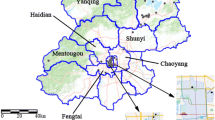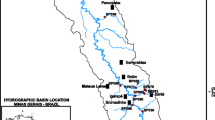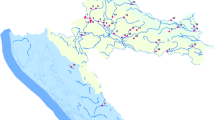Abstract
A confirmatory method for the determination of organochlorine pesticides (OCPs) and their metabolites (endrin, α-endosulfan, β-endosulfan, endosulfan sulfate, heptachlor, heptachlor epoxide, 2,4′-DDD, 4,4′-DDD, 2,4′-DDE 4,4′-DDE, 2,4′-DDT, and 4,4′-DDT) in surface waters using liquid chromatography /APCI/tandem mass spectrometry has been developed. Chromatographic separation was carried out on a ChromSpher 5 Pesticide column using a gradient elution with mobile phase 1mM ammonium acetate-acetonitrile. Endrin, α-endosulfan, β-endosulfan , endosulfan sulfate, heptachlor and heptachlor epoxide were determined in the negative ionization mode, while the rest compounds in positive ionization mode. For the identification of the analytes, two multireaction monitoring transitions were selected per compounds except for the heptachlor which selected ion monitoring was used. The linearity of the optimized method ranges after SPE concentration, from 0.009 to 30.60 μgL−1 with correlation coefficients greater than 0.99. The method recovery values varied from 72 to 119 % for the different fortification levels . The developed method was successfully applied to determine OCPs and their metabolites in surface water samples collected near paddy fields in growing season of rice, at year 2005 in Pathumthani province, Thailand. Endosulfan sulfate was detected in five out of seven samples and three of them could be quantitated in the range of 0.31to 0.50 μgL−1.






Similar content being viewed by others
References
Santos FJ, Galceran MT (2002) Trends Anal Chem 21:672–685
Murayama H, Moriyama N, Mitobe H, Mukai H, Takase Y, Shimizu K, Kitayama Y (2003) Chemosphere 52:825–833
Shen L, Wania F, Lei YD, Teixeira C, Muir DCG, Bidleman TF (2005) Environ Sci Technol 39:409–420
Fu S, Chu S, Xu X (2001) Bull Environ Contam Toxicol 66:171–177
Nerín C, Battle R, Sartaguda M, Pedrocchi C (2002) Anal Chim Acta 464:303–312
Columé A, Cárdenas S, Gallego, Valcárcel M (2001) Talanta 54:943–951
Aguilar C, Borrull F, Marcé RM (1997) J Chromatogr A 771:221–231
Jackson GP, Andrews ARJ (1998) Analyst 123:1085–1090
Magdic S, Pawliszyn JB (1996) J Chromatogr A 723:111–122
Li H-P, Li G-C, Jen J-F (2003) J Chromtogr A 1012:129–137
Dong C, Zeng Z, Yang M (2005) Water Research 39:4204–4210
Keinhuis PGM, Geerdink RB (2000) Trends Anal Chem 19:460–474
Wang D, Atkinson W, Hoover-Miller A, Li QX (2005) Rapid Commun Mass Spectrom 19:1815–1821
Patel K, Fussel RJ, Hetmanski, Gooddall DM, Keely BJ (2005) J Chromatoger A 1068:289–296
Borb da Cunha AC, López de Alda MJ, Barceló D, Pizzolato TM, Henrique Z dos Santos J (2004) Anal Bioanal Chem 378:940–954
Chiron S, Dupas S, Scribe P, Barceló D (1994) J Chromatogr A 665:295–305
Slobodník J, Hogenboom AC, Louter AJH, Brinkman UATh (1996) J Chromatogr A 730:353–371
Concha-Graña E, Turnes-Carou MI, Muniategui-Lorenzo S, López-Mahía P, Fernández-Fernández E, Prad-Rodríguez D (2001) Chromatographia 54:5–1–506
Sutthivaiyakit P, Achatz S, Lintelmann J, Aungpradit T, Charnwirat R, Chumanee S, Kettrup A (2005) Anal Bioanal Chem 381:268–276
Lintelmann J, Fischer K, Karg E, Schroeppel A (2005) Anal Bioanal Chem 381:508–519
Stemmler EA, Hites RA (1985) Anal Chem 57:684–692
Hernádez F, Sancho JV, Pazo O, Pitarch E (2001) J Chromatogr A 939:1–11
Council of the European Communities (1998) Directive 98/83/EC, Off J Eur Commun L 330/32
Mangani F, Maione M, Palma P. Analysis of Organochlorinated Pesticides in Water. In Nollet L M L, ed. Handbook of Water Analysis. New York: Marcel Dekker 517–536
Kruwal K, Sacher F, Werner A, Mueller J, Knepper TP (2005) Sci Total Environ 340:57–70
Acknowledgements
The financial support from the Postgraduate Education and Research Program in Chemistry (PERCH) and Kasetsart University is gratefully acknowledged. The authors thank Professor David L. Sedlak for the helpful discussion.
Author information
Authors and Affiliations
Corresponding author
Rights and permissions
About this article
Cite this article
Chusaksri, S., Sutthivaiyakit, S. & Sutthivaiyakit, P. Confirmatory determination of organochlorine pesticides in surface waters using LC/APCI/tandem mass spectrometry⋄. Anal Bioanal Chem 384, 1236–1245 (2006). https://doi.org/10.1007/s00216-005-0248-6
Received:
Revised:
Accepted:
Published:
Issue Date:
DOI: https://doi.org/10.1007/s00216-005-0248-6




